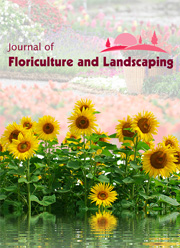Growing Dahlias, Dahlia coccinea Cav., for Commercial Cut Flower Production in Aquaponics and AutoPots
DOI:
https://doi.org/10.25081/jfcls.2022.v8.7510Keywords:
Dahlias, Aquaponics, Sustainability, Cut FlowersAbstract
Commercial floriculture is years behind food agriculture in the adoption of organic and sustainable practices and enacts a heavy toll on the environment, resulting in excessive water usage, soil erosion, heavy pesticide use, and a massive carbon footprint. In this study, Dahlias (D. Coccinea) were grown in AutoPots fed by an established aquaponics system to explore the sustainability and environmental impacts of aquaponics on commercial floriculture. Dahlias were grown starting from both tubers and cuttings, for a six month period, in a greenhouse setting, assessing the bloom time, bloom quality, stem count, pesticide usage, water usage, and tuber formation. Dahlias bloomed in a typical time frame, compared to field grown plants, the quality of the blooms was equivalent to field grown, the stem counts were significantly lower than field grown, pesticide usage was slightly decreased, water usage was dramatically lower than field grown, and tuber formation was not impacted. To date, this is the first published evidence that Dahlias can be grown in aquaponics, that typical environmental benefits were observed when growing Dahlias via this method, and tuber formation was not hindered by the high moisture conditions produced by a coupled aquaculture system.
Downloads
References
Bernstein, S. (2011). Aquaponic Gardening. Canada: New Society Publishers.
Buzby, K. M., West, T. P., Waterland, N. L., & Lin, L.-S. (2016). Remediation of Flow-Through Trout Raceway Effluent via Aquaponics. North American Journal of Aquaculture, 79(1), 53-60. https://doi.org/10.1080/15222055.2016.1221010
Dalsgaard, J., Lund, I., Thorarinsdottir, R., Drengstig, A., Arvonen, K., & Pedersen, P. B. (2013). Farming different species in RAS in Nordic countries: current status and future perspectives. Aquacultural Engineering, 53, 2-13. https://doi.org/10.1016/j.aquaeng.2012.11.008
Dole, J., & Wilkins, H. (2005). Floriculture: Principles and Species. (2nd ed.). Upper Saddle River, NJ: Pearson Education Inc.
IPCC. (2018). Summary of Plolicymakers. Special Report: Global Warming of 1.5 0C. Retrieved from https://www.ipcc.ch/sr15/chapter/spm
Joyce, A., Goddek, S., Kotzen, B., & Wuertz, S. (2019). Aquaponics: Closing the Cycle on Limited Water, Land and Nutrient Resources. In S. Goddek, A. Joyce, B. Kotzen & G. M. Burnell (Eds.), Aquaponics Food Production Systems Cham, Switzerland: Springer. https://doi.org/10.1007/978-3-030-15943-6_2
Kaplan, S. (2020). The Washington Post. Retrieved from https://www.washingtonpost.com/climate-solutions/2020/02/11/want-green-valentines-day-gift-dont-buy-chocolate-or-roses
Larson, R. A. (1992). Introduction to Floriculture. (2nd ed.). Netherlands: Elsevier.
Morse, D. L., Baker, E. L., & Landrigan, P. J. (1979). Cut Flowers: a potential pesticide hazard. American Journal of Public Health, 69(1), 53-56. https://doi.org/10.2105/ajph.69.1.53
Paletta, D. (2018). In rose beds, money blooms. Retrieved from https://www.washingtonpost.com/news/business/wp/2018/02/10/feature/colombia-rose-trade-industry-valentines-day
Rakocy, J. E., Bailey, D., Shultz, R. C., & Thoman, E. S. (2011). Update on Tilapia and Vegetable Production in the UVI Aquaponic System. Retrieved from https://web.archive.org/web/20130302224218/http://ag.arizona.edu/azaqua/ista/ista6/ista6web/pdf/676.pdf
RGJ Aquaponics. (2021). Water quality for plants. Retrieved from https://rgjaquaponics.weebly.com/plants-water-quality.html
Rinehart, L. (2019). ATTRA NCAT. Retrieved from https://attra.ncat.org/product/Aquaponics-Multitrophic-Systems-for-Sustainable-Food- Production
Stewart, A. (2007). Flower Confidential. US: Algonquin Books.
Toumi, K., Joly, L., Vleminckx, C., & Schiffers, B. (2017). Risk Assessment of Florists Exposed to Pesticide Residues through Handling of Flowers and Preparing Bouquets. International Journal of Environmental Research and Public Health, 14(5), 526. https://doi.org/10.3390/ijerph14050526
Toumi, K., Vleminckx, C., Loco, J. van, & Schiffers, B. (2016). Pesticide Residues on Three Cut Flower Species and Potential Exposure of Florists in Belgium. International Journal of Environmental Research and Public Health, 13(10), 943. https://doi.org/10.3390/ijerph13100943
USDA. (2020). Alternative Farming Systems Information Center. Retrieved from https://www.nal.usda.gov/afsic/aquaponics
USTR. (2008). Third Report to the Congress on the Operation of the Andean Trade Preference Act. Retrieved from https://web.archive.org/web/20080605220144/http://www.ustr.gov/assets/Trade_Development/Preference_Programs/ATPA/asset_upload_file215_3783.pdf
Wahome, P. K., Oseni, T. O., Masarirambi, M. T., & Shongwe, V. T. (2011). Effects of Different Hydroponics Systems and Growing Media on the Vegetative Growth, Yield and Cut Flower Quality of Gypsophila (Gypsophila paniculata L.). World Journal of Agricultural Sciences, 7(6), 692-698.
Whelan, C. (2009). Scientific American. Blooms Away: The Real Price of Flowers. Retrieved from https://www.scientificamerican.com/article/environmental-price-of-flowers/#:~:text=According%20to%20Flowerpetal.com%2C%20which,from%20field%20to%20U.S.%20florist
Wildrick, K. (2018). The Aquaponics Association. https://aquaponicsassociation.org/usda-reconfirms-organic-eligibility-of-aquaponics
Yep, B., Gale, N., & Zheng, Y. (2020). Aquaponic and Hydroponic Solutions Modulate NaCl-Induced Stress in Drug-Type Cannabis sativa L. Frontiers in Plant Science, 11, 1169. https://doi.org/10.3389/fpls.2020.01169
Published
How to Cite
Issue
Section
Copyright (c) 2022 Bella Dastvan, Joe Pate, John Dole, Tom Precht

This work is licensed under a Creative Commons Attribution 4.0 International License.



 .
.